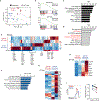CD103 fate mapping reveals that intestinal CD103- tissue-resident memory T cells are the primary responders to secondary infection
- PMID: 36332012
- PMCID: PMC9901738
- DOI: 10.1126/sciimmunol.abl9925
CD103 fate mapping reveals that intestinal CD103- tissue-resident memory T cells are the primary responders to secondary infection
Abstract
Tissue-resident memory T (TRM) cells remain poised in the tissue and mediate robust protection from secondary infection. TRM cells within the intestine and other tissues are heterogeneous in their phenotype and function; however, the contributions of these TRM subsets to secondary infection remain poorly defined. To address the plasticity of intestinal TRM subsets and their role in local and systemic immunity, we generated mice to fate map intestinal CD103+ TRM cells and track their location and function during secondary infection with Yersinia pseudotuberculosis. We found that CD103+ TRM cells remained lodged in the tissue and were poorly reactivated during secondary challenge. CD103- TRM cells were the primary responders to secondary infection and expanded within the tissue, with limited contribution from circulating memory T cells. The transcriptional profile of CD103- TRM cells demonstrated maintenance of a gene signature similar to circulating T cells along with increased cytokine production and migratory potential. CD103- TRM cells also expressed genes associated with T cell receptor (TCR) activation and displayed enhanced TCR-mediated reactivation both in vitro and in vivo compared with their CD103+ counterparts. These studies reveal the limited recall potential of CD103+ TRM subsets and the role of CD103- TRM cells as central memory-like T cells within peripheral tissues.
Conflict of interest statement
Figures






References
-
- Mueller SN, Mackay LK, Tissue-resident memory T cells: local specialists in immune defence. Nat Rev Immunol. 16, 79–89 (2016). - PubMed
-
- Gebhardt T, Wakim LM, Eidsmo L, Reading PC, Heath WR, Carbone FR, Memory T cells in nonlymphoid tissue that provide enhanced local immunity during infection with herpes simplex virus. Nat Immunol. 10, 524–530 (2009). - PubMed
Publication types
MeSH terms
Substances
Grants and funding
LinkOut - more resources
Full Text Sources
Other Literature Sources
Research Materials

